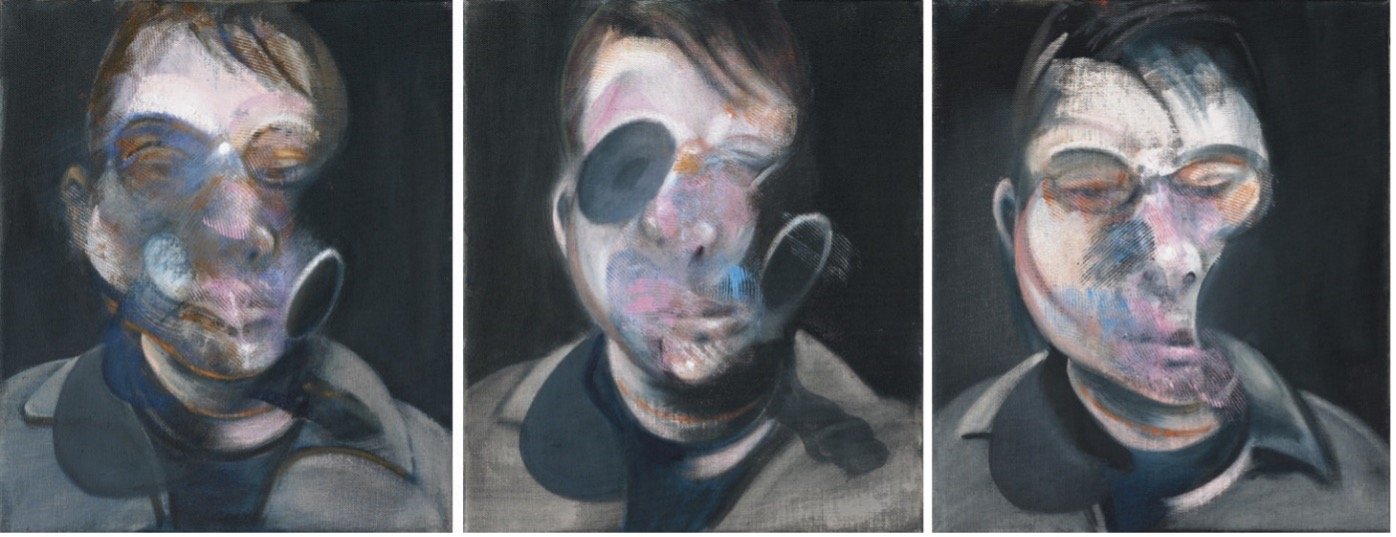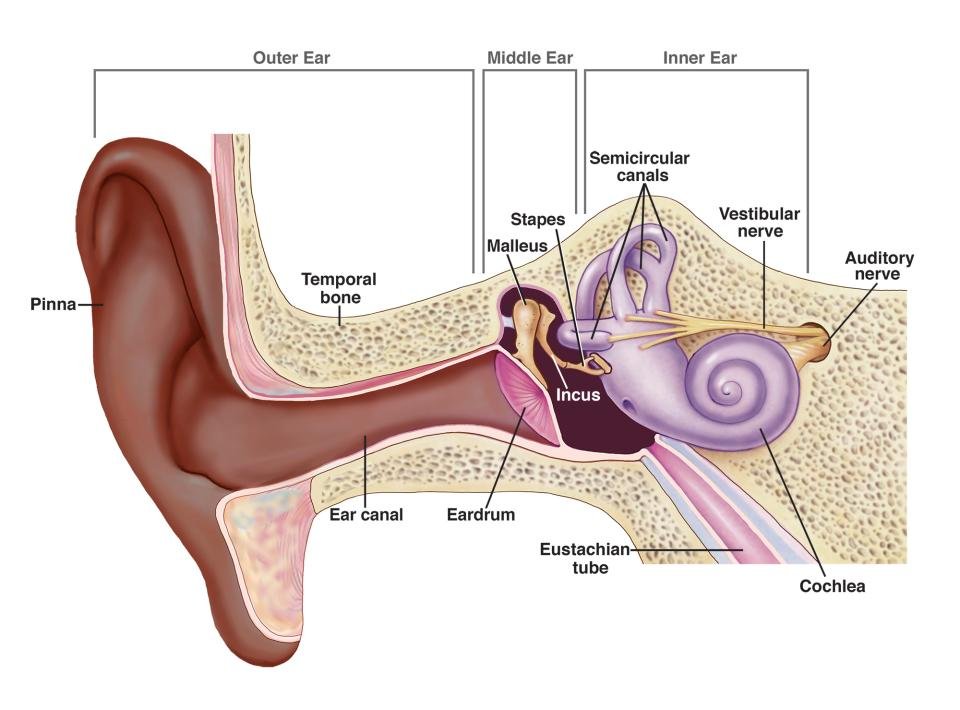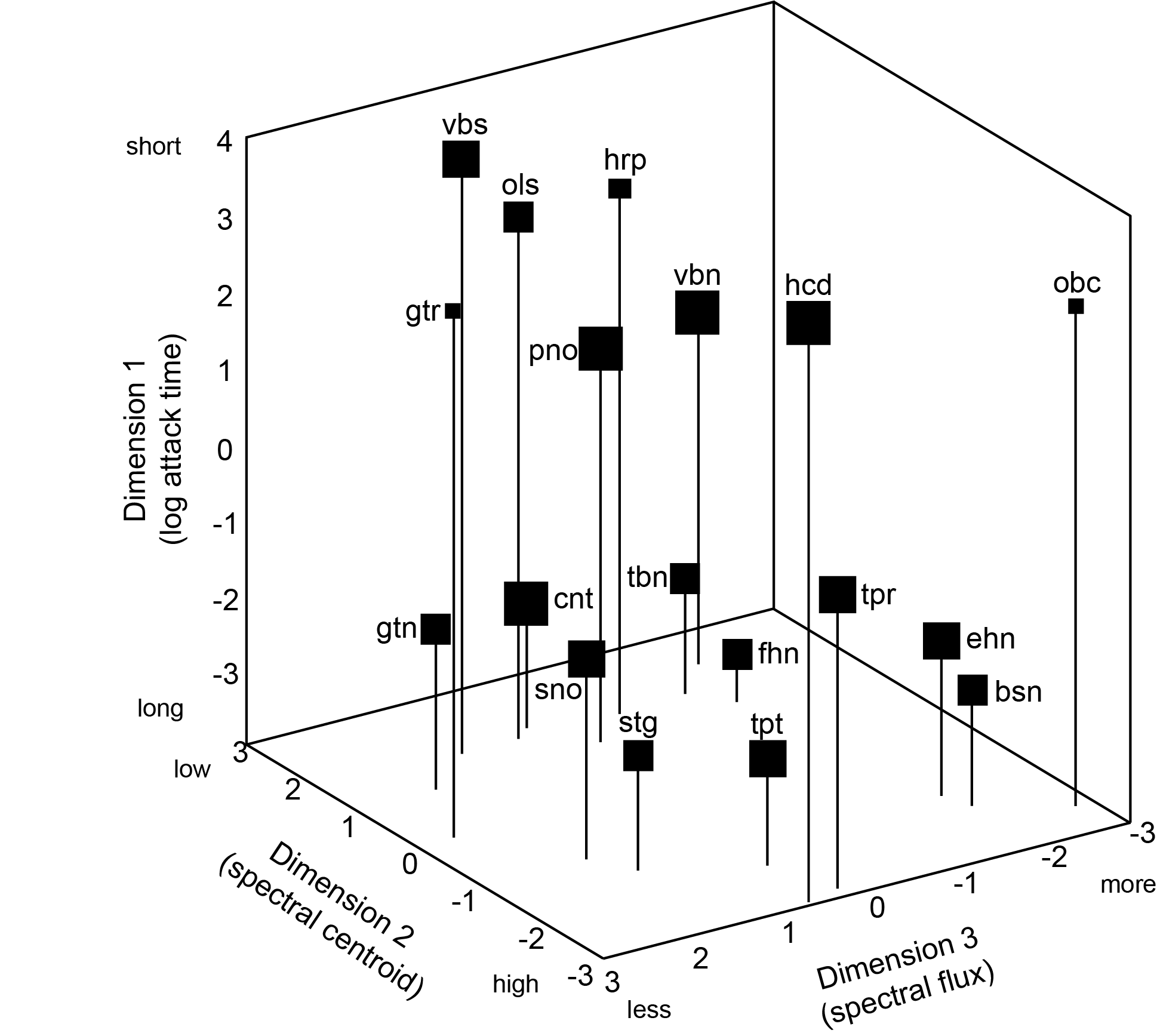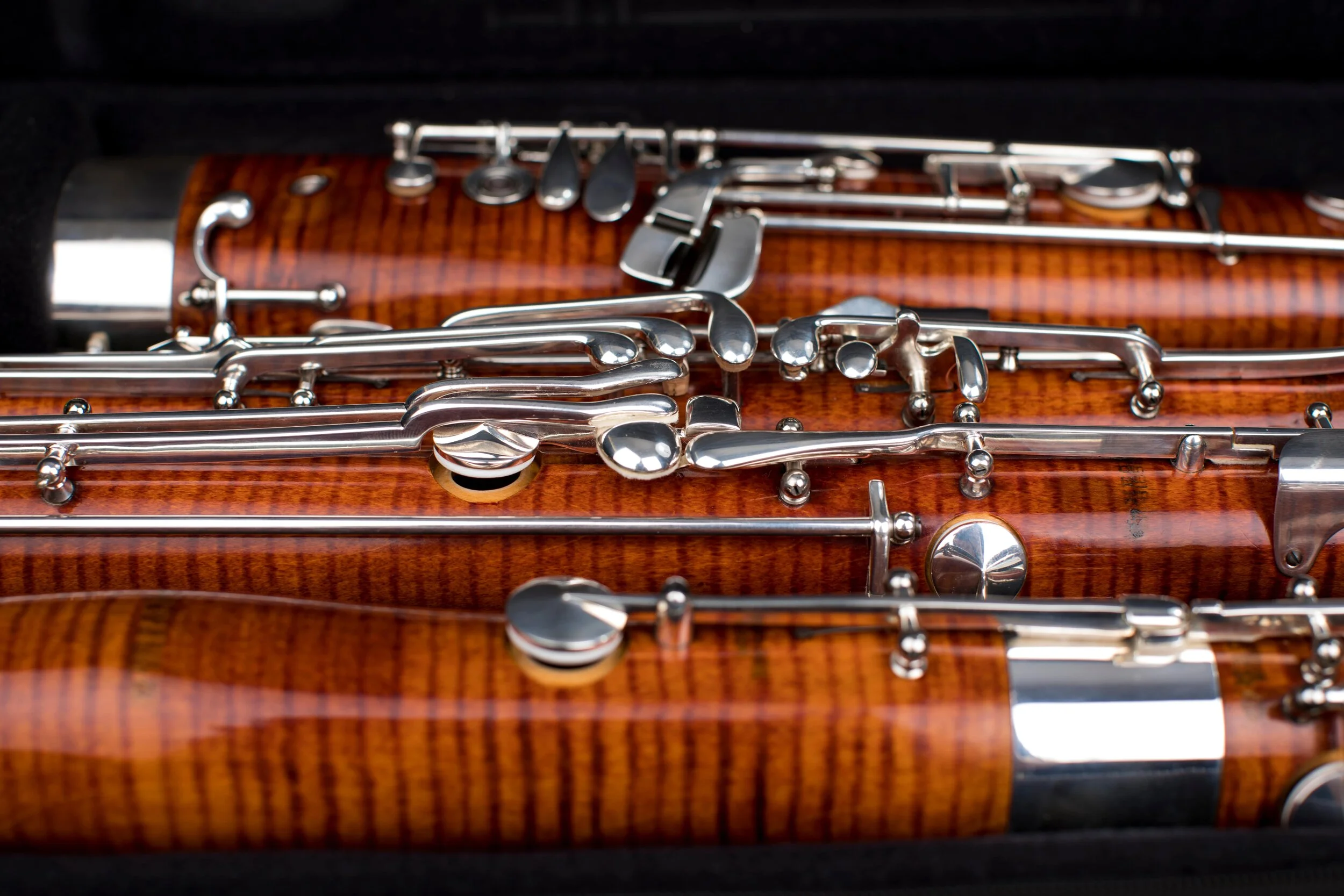
Professor Bad Trip: Lesson III — Fausto Romitelli
Professor Bad Trip: Lesson III (2000) is a piece for small ensemble composed by Fausto Romitelli, constituting the last part of his Professor Bad Trip triptych (1998–2000). As suggested by the title, Romitelli sought an aesthetic that evokes hallucination, plunging the listener into a state of illusion and bewilderment.


Klangfarbenmelodie
A compositional technique where a musical line or melody is split between several instruments, rather than being played by a single instrument. Each instrument plays a note or a short succession of notes, creating a continuous melody with a constantly changing timbre or "tone colour.”

Masking
Suppose you enter a restaurant with a friend, mid-conversation. As you enter, you are greeted by the background noise of other patrons’ conversations. You and your friend begin to speak louder so you can hear one another. You’ve just experienced masking, a very familiar yet fascinating phenomenon that many of us encounter every day without even noticing.

Spectral Envelope
In the process of analyzing the spectrum of a sound, it is sometimes useful to describe its spectral properties in terms of energy distribution rather than individually mapping all its components. In so doing, we invoke the concept of spectral envelope, a curve that can be obtained by successively connecting the peaks of the partials shown in the frequency representation of the sound (i.e., with frequency on the x-axis and energy or amplitude on the y-axis). Spectral envelopes are important factors in timbre perception. They reflect the acoustic properties of an object that produces sound in terms of the energy distribution across the frequency spectrum.

Spectrogram
Just as a frequency spectrum makes it possible to analyze the partials and noise components that make up a sound, a spectrogram can be used to visualize the evolution of these components of a sound over time. The first modern device able to produce such a representation of sound was the “sound spectrograph,” developed at Bell Telephone Laboratories in the 1940s [1]. A spectrogram has a very intuitive way of displaying its parameters. Just as in a musical score, time is represented on the x-axis, frequency on the y-axis, and energy/amplitude is determined by the intensity/hue of the colors.

Timbre Space
A sound’s timbre can be represented by a point inside a conceptual timbre space, a space where the axes are usually defined by the principal attributes (e.g., spectral centroid, attack time) that one would implicitly use to perceive or conceive any timbre in a given context. Timbre spaces are obtained using a statistical method called multidimensional scaling analysis (MDS), which generates a simplified multidimensional map from a series of perceptual distances between pairs of timbres (as measured in perceptual experiments). The experimenter then deduces the attributes (acoustic descriptors) that best describe the axes obtained. Timbre spaces provide us with complementary information to the neuro-cognitive mechanisms of timbre perception, and can also be a very useful compositional tool.

Icicle — Robert Aitken
Icicle (1977) for solo flute, by Canadian composer, conductor, and flautist Robert Aitken, captures a quintessentially winter soundscape with its highly variable timbral palette. Audible right from the beginning of Nina Assimakopoulos’s 2021 recording, Icicle is saturated with timbres that evoke such cold, wintry imagery as glistening icicles and blowing snow. The wintry timbres in Icicle are created by various extended playing techniques.

Tension and the Cello — Kaija Saariaho’s Petals
Kaija Saariaho’s Petals (1988) transforms the cello into a diverse musical instrument capable of creating countless varying sounds. Her organization of sounds produces two distinct timbral profiles that alter throughout the work, governing its two-part structure. Different music variables, including temporal perception, sound characteristics, spectral density, and attack, are employed by each profile to construct several binaries that either produce a state of tension or relaxation. The superimposition of profiles towards the end of Petals begets the work’s climax by maximizing tension. Saariaho therefore develops a narrative that explores opposing approaches to the creation and dissolution of tension through timbre.

Death, Sex, and the Semitone in Monteverdi’s “Pur ti miro, pur ti godo”
In this edition of Amazing Moments in Timbre, I will explore the timbral representation of sex (and maybe death) in “Pur ti miro, pur ti godo,” the final love duet between Poppea and Nerone in Monteverdi’s opera (on a libretto by Busenello), L’incoronazzione di Poppea. Martha C. Nussbaum, in Upheavals in Thought (2012), describes the duet as “an extraordinary depiction of lovemaking,” presumably in part because of the tension and release created by the numerous harmonic clashes and resolutions in the piece. Meanwhile, music librarian and blogger Pessimisissimo interprets the dissonance as follows:

Passaggio and Register in the Singing Voice
Passaggio, an Italian word translating to passage or transition, is the bane of many a classical singer and the secret weapon of folk-inspired vocalists like Dolores O’Riordan, Jewel, and Sarah McLachlan. In English we often refer to this as “the break.” One of the main goals of classical vocal technique is smoothing out register breaks. This requires finesse, patience, and perseverance. It is a process that cannot be rushed because singing in the passaggio for extended periods of time can mentally and physically tax even experienced singers, causing serious vocal fatigue.

The Alchemical Wedding — Liza Lim
In The Alchemical Wedding (1996), for large ensemble, Australian composer Liza Lim seeks contact points between “seemingly disparate musical entities” (1996)—a pursuit reflected in the work’s title. This virtual contact is evidenced by the work’s peculiar instrumentation, where the Chinese Er-hu and Indonesian Angklung are pitted against a large Western ensemble. Reflecting the cultural fusion of composer’s upbringing between Australia and various Asian countries, The Alchemical Wedding represents a marriage of musical possibilities through the collision of Asian and Western instruments and aesthetics.

Timbral Progression in Rebecca Saunders’ dichroic seventeen
Abstract: This short essay will investigate how Rebecca Saunders uses several orchestration techniques to create a timbral progression in her work dichroic seventeen in order to emulate the visual phenomenon of dichroism.

Pour l’image — Philippe Hurel
The opening section of the ensemble piece Pour l’image by Philippe Hurel is underpinned by a series of orchestration approaches that work in concert to generate large-scale musical transition. The first prominent transition happens in the first 15 measures, traversing from a complex timbral agglomerate to a transparent polyphonic texture. The second transition happens in mm. 22-45 where a harmonically and timbrally dissonant texture gradually condenses into a passage of consonant chordal echoes.

Vibrato
Sound is vibration! Repeated, continuous vibration of the air creates sustained sounds. Within sustained sounds, vibration modulations are a natural component of both vocal and instrumental music. Patterns of vibration modulations are perceived by the human ear, and we call them vibrato. Vibrato is commonly accepted to be a distinctive feature of musical sound, inextricably tied to artistic expression and timbre.

Timbre as an Impassioned Argument: Maconchy’s String Quartet No. 10
In a brief article from 1971, British composer Elizabeth Maconchy (1907–94) stated that the string quartet is “above all best suited to the expression of the kind of music I want to write – music as an impassioned argument.” Maconchy’s highly dissonant String Quartet No. 10 (1972) exemplifies this compositional philosophy.

Lovin’ You — Minnie Riperton
The 1975 live version of Minnie Riperton’s “Lovin’ You” sets itself apart from her 1974 album, Perfect Angel, not just because of its extended length but also because of Riperton’s whistle register ad-lib in the middle of modal register singing.

Bound to You — Christina Aguilera
In a moment of vocal, narrative, and timbral intensity, Christina Aguilera’s performance as the character Ali in the 2010 film Burlesque shatters the viewers’ expectations.

Cinq danses profanes et sacrées — Henri Tomasi
The sound of today’s bassoon far exceeds the range and intensity of its ancestors, and recent music written for the bassoon has increased in variety and complexity accordingly. Extended techniques for bassoon, including multiphonics and timbral trills, create entirely new and almost uncharacteristic timbres, ones that listeners cannot even identify as bassoon sounds. Thus, the timbral lexicon for bassoon could use some updates.

Cellophane — FKA twigs
A tragic ode to perseverance and rebirth, “Cellophane” tackles the intense emotions of a public celebrity romance scrutinized by online critics. In “Cellophane,” repetitive lyrical content such as “didn’t I do it for you?” express twigs’s disbelief in her own crumbling relationship while other lyrics (e.g., “they want to see us, want to see us apart”) relate to the taxing nature of online comments.

Blood, Glass, and a Cannibal’s Beating Heart — Brian Reitzell
Much of the piece’s effect is accomplished by Reitzell’s intentional manipulation of timbral signifiers. Most attacks have been removed in a kind of electronic vivisection – a commingling of the known and the unknown that creates ambiguity in the sonic space.

Subwhistle — Brian Jacobs
I am standing on a rainforest floor. Surrounding me, but in my aural periphery, a million insects murmur, forming a sonic haze as impenetrable as the thick vegetation. My focus is drawn towards the canopy, where a few birds converse, hidden from view.

Koan — James Tenney
In 1971, American composer James Tenney wrote the solo violin piece Koan as part of his Postal Pieces. The score is contained entirely on a postcard consisting of only seven measures. A string quartet arrangement of Koan, written by Tenney in 1984, retains the original violin line but adds a further harmonic context in the remaining three instruments.

different forms of phosphorus — Karola Obermüller
Jaqueline Leclair’s album Music for English Horn Alone, released in October 2020, represents a landmark for the versatile—but often underestimated—English horn. In particular, the album showcases the colorful timbral palette of the instrument through both traditional modes of playing and extended techniques. This is the first part of two blogs addressing pieces on Leclair’s new album.

Instrumental synthesis
Instrumental synthesis is a technique for composition and orchestration first developed in the 1970s. It is a founding principle of French spectral music, represented at that time mainly by the composers Tristan Murail, Hugues Dufourt, and Gérard Grisey. This type of compositional process could not have existed without the technological progress in musical acoustics made in the previous decades…
La synthèse instrumentale est une technique d’écriture et d’orchestration développée principalement dans les années 1970-1980. C’est le principe fondateur du courant de la musique spectrale, né en France et principalement représenté par les compositeurs Tristan Murail, Hugues Dufourt et Gérard Grisey à cette époque. Ce procédé compositionnel n’aurait pas pu exister sans les progrès technologiques en acoustique des dernières décennies.

Schnittke’s Concerto Grosso No. 1
Alfred Schnittke’s Concerto Grosso No. 1 (1977), composed at the height of his “polystylistic” period, is filled with diverse musical materials. The 28-minute piece is divided into six movements combining different musical genres, styles, and sonorities. As musicologist Maria Bergamo describes, “The musical ideas, the themes and motives of the work are linked in all six movements, gaining new interpretations and aspects by varied treatment and paraphrases.”[1] For this Amazing Moment in Timbre, I will describe the interaction of timbres in the second movement, the Toccata, focusing on two main timbral features: sound mass and textural integrations.

The children of fire come looking for fire — Eric Wubbels
As stated in the album liner notes for Eric Wubbels’s Duos with Piano Book I, “these pieces aim to develop a 21st-century conception of ensemble virtuosity (now a virtuosity of listening, concentration, timbral fusion, and collaborative decision-making as much as of technique) in the microcosm of the duo format.” “the children of fire come looking for fire” (2012), for violin and prepared piano, stays true to Wubbel’s stated aim not only in its inventive combination of similar gestures in differing instruments, but also in its use of these individual instruments to highlight the and forefront each other’s particular timbral qualities.

Brightness / Darkness
“Brightness” is one of the most common terms used to describe sounds, drawing on strong cross-modal associations. Most people can call to mind examples of “bright” sounds: what do these sounds have in common?
Most sounds are made up of multiple different sound components, including partials and noise components. The relations between sound components have a big impact on how the overall sound is perceived:

Buzzard and Kestrel — James Blake
A snare drum pounds relentlessly for the first sixty seconds of James Blake’s “Buzzard and Kestrel,” punctuated by random swoops of vocoderised voices, the occasional handclap, and an intermittent sub-bass almost at the edge of hearing. As the drum pattern repeats again and again, its reverberation steadily grows until the entire track is blanketed in a continuous sizzle. At its peak, around 0:56, the drum’s attacks are almost completely swallowed by their own echoes, the reverb an unremitting rush in our ears…
Then, something amazing happens.

The Colour “Fresh”: Timbre in Intermezzo no. 1 — Yinam Leef
No doubt, a stirring sense of vitality captures you from the very first moment of this miniature. But what is it that is so captivating about this Intermezzo? Clearly, the composer focuses our attention on a very particular technique of orchestration that he uses throughout. Nevertheless, we don’t get tired of it: it stays fresh long after we recognize this particular orchestration as a main expressive element…

The Singer’s Formant
Have you ever wondered how opera singers sing so loudly? In the voice studio, operatic singing is not actually thought of as loud but rather as possessing resonance (in singers’ terms, not acousticians’ terms), focus (sometimes visualized as a laser point), cut (a non-technical term meaning the voice can cut through the texture of an orchestra), or squillo (an Italian word for the buzzy quality in an operatic voice). A classically trained voice can be heard despite being accompanied by strings, percussion, woodwinds, and, in the case of Wagner’s Die Walküre, twenty-two brass instruments.

Flourish — Sarah Hennies
From the very beginning of the piece, Sarah Hennies’s Flourish for two vibraphone players, leads us into an extraordinary, mystical, new world of sound. What is so enigmatic about this piece is that a lot of the music happens in a realm of timbre beyond what is written and what is played. Precisely and cleanly scored in minimalist fashion of single-measure repeating cells, the atmospheric reverberations produced by the vibraphone are here left to write their own counterpoint….

Inharmonicity
Inharmonicity is a feature of timbre that is related to the frequency spectrum of a given sound. It is measured through an analysis of the partials (see https://www.actorproject.org/timbreducation/timbre-term-of-the-week-1), or, more precisely, of their frequencies and the intervals between them….

The Unanswered Question – Charles Ives
In 1908, American composer Charles Ives composed The Unanswered Questionfor string orchestra, solo trumpet (or English Horn) and four flutes (or three oboes and one clarinet). This piece inspired Leonard Bernstein’s famous Norton Lectures of the same title at Harvard in 1973 and continues to capture the imaginations of musicians and audiences today….

Spectral centroid
Spectral centroid is an acoustical descriptor of timbre. Its value is obtained through a statistical measurement on the frequency representation of the signal (the frequency spectrum - see Timbre Term of the Week "Signal vs Spectrum"). As its name says, centroid is a spectral descriptor and corresponds to a specific type of estimation of the spectral shape (or curve)…

Red Bird —Trevor Wishart
Trevor Wishart is a contemporary British composer closely associated with extended uses of the human voice. Whether in acousmatic pieces such as Encounters in the Republic of Heaven (2011) or in pieces for live performance such as Vox 4(1987), his compositions masterfully exploit the subtlety and range of human vocal production…

Menotti’s Goya and The Timbre of Tinnitus
When considering the compositional problem of Goya’s deafness, Gian Carlo Menotti may have struggled to find the best approach. However, forty years prior to the première of Goya (1986), he had already explored the issue of muteness …

Signal vs. Spectrum
In everyday life, sounds are captured by our auditory system and analyzed in our brains. But in order to better understand the physical phenomena that comes with sound production, we use analytical methods, both analog and computational, that are based on different representations of the sound vibration.

Hommage à Klaus Nomi
The Amazing Moments in Timbre series continue with a piece by Olga Neuwirth. Known as the "Enfant terrible" of the Austrian contemporary classical music scene, Neuwirth composes in a very theatrical and expressionist way, and describes her own art as a music of catastrophes ("Katastrophenmusik"). In her Hommage à Klaus Nomi(2009), for countertenor and chamber ensemble…

Shepard Tone
In this post Auditory Scene Analysis, we introduced some of the ways that sound components are grouped together by the auditory system. This has many musical applications, and also lays the foundation for some interesting auditory illusions. One of the most famous is the Shepard Tone, named for cognitive scientist Roger Shepard, which creates an illusion of perpetual ascent or descent. A quick search on YouTube will turn up many examples; here is a handful:

Deus Cantando — Peter Ablinger
This week’s amazing moment in timbre is a bit of a mind-bender: a piano that recreates the timbre of the human voice. It’s Peter Ablinger’s Deus Cantando (2009). for a piano being played by a computer-controlled mechanical device. Watch and be wowed:

Auditory Scene Analysis
This is a spectrograph, a way of visualizing sound in which the y axis represents frequency, the x axis represents time, and darkness or colour represents concentration of energy. Looking from bottom to top shows how the sound energy is distributed on the continuum from low to high, and looking from left to right shows how that distribution changes over time...

Envelope
In synthesis and sound recording and mixing, envelope describes how a sound’s amplitude (volume) changes over time. When recreating the timbre of an instrument (or other sounds such as a firetruck siren), it is equally important to get the overtone series right as it is to reconstruct or preserve the contour of the sound….


Dripsody — Hugh Le Caine
Our second Amazing Moment in Timbre is another classic, but somewhat lesser-known. It’s Canadian composer and inventor Hugh Le Caine’s Dripsody(1955).

Atmosphères — György Ligeti
We’re beginning our “amazing moments in timbre” series with a true classic, György Ligeti’s paralyzingly beautiful orchestral masterpiece Atmosphères(1961)…

Partial
Although we may perceive sounds such as musical notes as singular, self-contained units, the physical reality often suggests something very different. Most sounds we hear are actually complex mixtures of many different sound components, some of which are noisy and transient, others of which may have stable frequencies…
